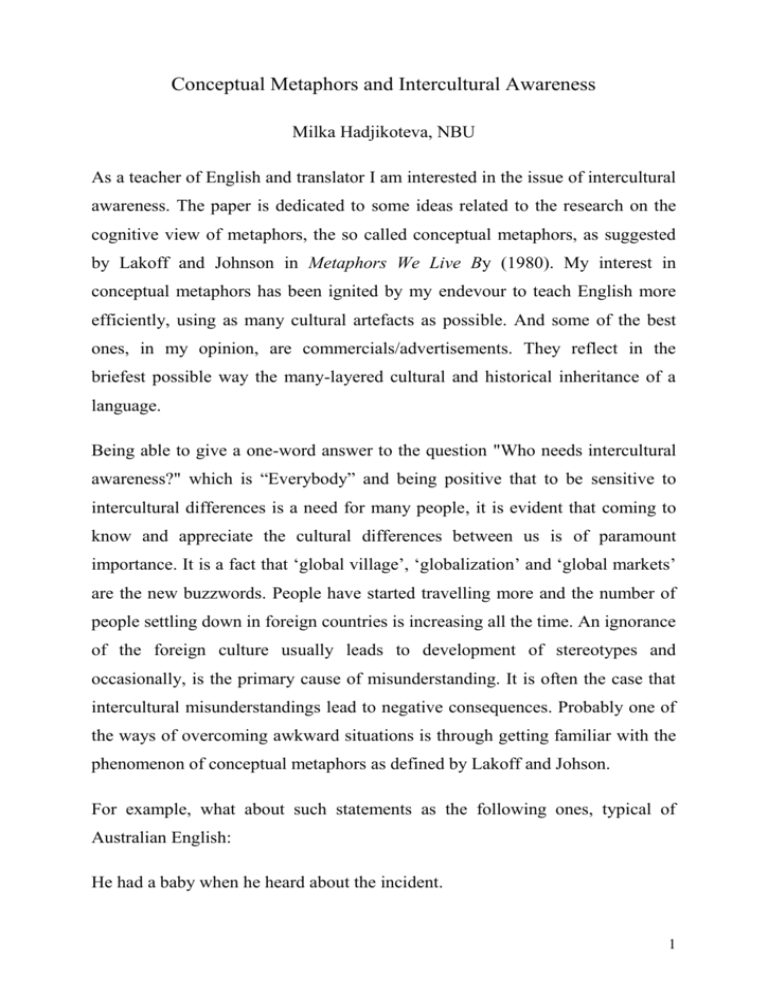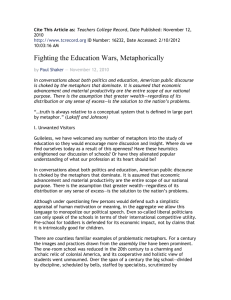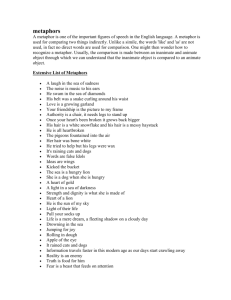Conceptual Metaphors and Intercultural Awareness
advertisement

Conceptual Metaphors and Intercultural Awareness Milka Hadjikoteva, NBU As a teacher of English and translator I am interested in the issue of intercultural awareness. The paper is dedicated to some ideas related to the research on the cognitive view of metaphors, the so called conceptual metaphors, as suggested by Lakoff and Johnson in Metaphors We Live By (1980). My interest in conceptual metaphors has been ignited by my endevour to teach English more efficiently, using as many cultural artefacts as possible. And some of the best ones, in my opinion, are commercials/advertisements. They reflect in the briefest possible way the many-layered cultural and historical inheritance of a language. Being able to give a one-word answer to the question "Who needs intercultural awareness?" which is “Everybody” and being positive that to be sensitive to intercultural differences is a need for many people, it is evident that coming to know and appreciate the cultural differences between us is of paramount importance. It is a fact that ‘global village’, ‘globalization’ and ‘global markets’ are the new buzzwords. People have started travelling more and the number of people settling down in foreign countries is increasing all the time. An ignorance of the foreign culture usually leads to development of stereotypes and occasionally, is the primary cause of misunderstanding. It is often the case that intercultural misunderstandings lead to negative consequences. Probably one of the ways of overcoming awkward situations is through getting familiar with the phenomenon of conceptual metaphors as defined by Lakoff and Johson. For example, what about such statements as the following ones, typical of Australian English: He had a baby when he heard about the incident. 1 She’ll have kittens if she finds out about it. Don’t have a cow! It’s no big deal! Aren’t they going to create many misunderstandings for those who are not aware of the fact that these expressions exist in the language to describe the state of ANGER? And isn’t it a problem of understanding metaphors? The word “metaphor” in Greek meant "carry across" or "transfer". It is usually used to refer to the method of comparing two different items based on resemblance or similarity. For instance, "her eyes were ponds", "she carried her guilt", and "my brother is a plague", are all examples of metaphoric language use. But the cognitive view of metaphors sees metaphors as cognitive instruments. Metaphors are a matter of cognition and are fundamental to conceptualising the world. Metaphor is a mapping across conceptual domains, from source to target, and normally from the concrete to the more abstract. Lakoff and Johson (1980:3) consider metaphor as a universal capacity that structures the way people think. “… metaphor is pervasive in everyday life, not just in language but in thought and action. Our ordinary conceptual system, in terms of which we both think and act, is fundamentally metaphorical in nature.” The conceptual metaphor [MORE IS UP], [LESS IS DOWN], for instance, employs the embodied concept of vertical space and the coordinates up and down as a source domain to understand the more abstract concept of quantity as a target domain. A conceptual domain may be any coherent organization of experience. A mapping is considered the systemic set of correspondences that exist between the constituent elements of the source domain and the target domain. In fact, to employ a conceptual metaphor means to be aware of the set of mappings that applies to a given source-target pairing. The mappings of a conceptual metaphor are motivated by image schemas which are pre-linguistic schemas concerning space, time, moving, controlling, established in result of embodied human 2 experience, and consequently are universal to people all over the world, no matter what their native language is. Thanks to the metaphoric nature of thinking people understand unknown or abstract phenomena by means of familiar concepts. Different concepts, such as time, love, hatred; different states, events, actions, purposes, means are made sense of thanks to metaphorical understanding. Though abstract understanding of these fundamental domains is carried out thanks to the metaphor, regarded as a process (conceptual metaphor), its linguistic products (metaphoric expressions) are specific for each culture, i.e. metaphors as linguistic realizations of mental image schemes are undoubtedly culture-specific. Obviously, the conceptual metaphor underlying the abovementioned expressions may be formulated as [ANGER IS GIVING BIRTH], which is culturallyspecific for Australian English. There are words and expressions with similar literal meanings in English and Bulgarian language, but these meanings are metaphorically extended in different ways. This can be illustrated with the uses of colours in English. The basic meaning of “green”as colour is shared in most languages, but the metaphorical extension in the phrase “to have green fingers” (“to be unusually successful in making plants grow”) does not exist in many of them. It may be argued, of course, that “green” is used in most languages when talking about environment and nature, but the metaphorical extension of the above-mentioned phrase is not utilized in Bulgarian language. A similar study of the use of the colour “red” may be carried out. While sharing the same literal meaning, there are equivalent expressions which instantiate common conceptual metaphors and may be classified under the first combination, as well as expressions instantiating culturally-specific conceptual metaphors. An example of equivalent expressions which instantiate common conceptual metaphors in English and Bulgarian is the expression “in the red”, instantiating the conceptual metaphor [DEBT IS 3 COLOUR]. An example of a culturally-specific metaphoric expression is “to paint the town red”, meaning “enjoy oneself flamboyantly”. The balance between universality and cultural specificity is of utmost importance when dealing with metaphoric expressions. The notions of coherence and cohesion are important for establishing the balance. Coherence, or the way meanings and sequences of ideas relate to each other, for example general in relation to particular; a statement in relation to an example; a problem in relation to a solution; a question in relation to an answer; a claim in relation to a counter-claim, is the key element when talking about interpretation and teaching. Cohesion, or the ways these universal relations are expressed through the use of sentence patterns, pronouns, transition words, synonyms, metaphoric expressions, is language-specific. Culturally-specific phenomena are salient in linguistic manifestations of metaphors in texts, while the underlying relations are shared and universal. On the basis of research carried out by Zoltan Kovecses (2002) it turns out that there are universal conceptual metaphors which ground similar linguistic expressions in English, Hungarian, Polish, Chinese, Zulu and as far as some research shows in Bulgarian as well. Some of the universal metaphors pointed out are the following: [HAPPINESS IS UP] (to feel up; high spirits) [HAPPINESS IS LIGHT] (to radiate joy; a glow of happiness on the face; shining with joy) [HAPPINESS IS A FLUID IN A CONTAINER] (to be filled with joy; to brim over with joy; to bubble over with joy; to overflow with joy; to burst with happiness) [ANGER IS A PRESSURIZED FLUID OR GAS IN A CONTAINER] (to boil with anger; to make one’s blood boil; to simmer down; to blow your stack) 4 Many of the universal conceptual metaphors are being employed more and more frequently in advertising. For example, the visual expression of the conceptual metaphor [LIFE IS A JOURNEY] has been used by Samsonite to promote their goods in the following advertisement: Тhe same conceptual metaphor can be instantiated by linguistic expressions, such as: to get a head start in life; to be without direction in one’s life; to be where smo. wants to be in life; to be at a crossroads in smo’s life; to go places in life; to let smo get in smo else’s way; to go through a lot in life; to cruise down the highway of success; to slow down and think about what to do; to live my life in the fast lane. All these examples have to do with mapping the characteristic of speed in the source domain of JOURNEY to the domain of LIFE. Such analogies shed light on the issue of universality vs. cultural-specificity, namely that linguistic expressions of a conceptual metaphor may be shared by many different cultures. Further examples, supporting the conclusion are: 5 [LIGHT IS KNOWLEDGE][DARK IS IGNORANCE] to be illuminated to be left in the dark about what happened a clear explanation an obscure idea to shed light on an issue The visual expressions of the above-mentioned conceptual metaphor may be shown in the following representations: The conceptual metaphor [THEORIES ARE BUILDINGS] is explified by the following linguistic expressions: to assemble/construct a theory to support a theory a theory collapses a framework of a theory a well-constructed theory A similar one is [LEARNING AS BUILDING] which substantiates the idea of constructing knowledge and is instantiated in expressions such as “build your vocabulary” and “build your English skills”, which were used by the Pharos English language centre in Bulgaria, advertising its English language courses sy stating “BUILD YOUR ENGLISH”. 6 Drawing parallels or contemplating how different the conceptual metaphors of the two languages are may lead to developing intercultural awareness. Based on the fact how wide-spread visual expressions and linguistic expressions of so many conceptual metaphors are, I think it is important to pay extra attention to the culturally-specific ones, especially the ones which may cause intercultural misunderstanding. In the globalised world of ours, it is really essential to be familiar with the cultural phenomena of as many cultures as possible. And, in my opinion, it is the point where conceptual metaphors come into play. References: Lakoff, G. and Johson, M. (1980) Metaphors We Live By, Chicago, Chicago University Press. Kovecses, Z. (2002) Metaphor. A Practical Introduction. Oxford. Oxford University Press. 7









